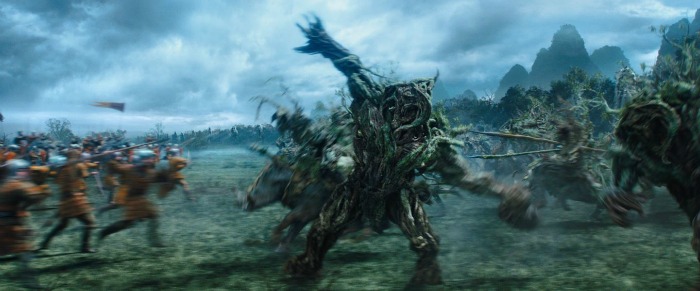Maleficent, Disney’s latest in a seemingly never-ending
series of big-budget live-action fantasy films, appears to be a dark film right
from the get-go. Thanks to what seems to be a Disney tradition of creating
misleading trailers, it hides the film’s relatively-light mood and instead
portrays an extremely dark film.
Maleficent is the perspective-flipped
live-action remake of Sleeping Beauty,
and if it’s one thing that die-hard fans of original films hate more than
sequels, it’s remakes. Especially remakes that tell the story from a different
point of view. Why? Quite often, discrepancies appear between the two movies. These
two can’t avoid that fatal flaw.
As a stand-alone movie, Maleficent is a decent film. As a
perspective-flipped remake, that depends on how protective you are of the
original material. Disney changes the names of characters, their alignments,
and what role they play in the film. Major characters get relegated to minor
roles too (joy!). Of course, all of this is in comparison to the original Sleeping Beauty. The creators quickly
cover for this by deeming Sleeping Beauty
as the “tale” and Maleficent the “truth”. Take it however
you’d like.
 Maleficent is the
debut film for director Robert Stromberg, who previously won 2 Academy Awards
in the fields of Production Design and Art Directon (the same category).
Writing the script is Linda Wollverton (Beauty
and the Beast, The Lion King, Alice in Wonderland). Unfortunately, this
movie is more akin to the most recent of that trio – a movie that focuses more
on visuals and less on story.
Maleficent is the
debut film for director Robert Stromberg, who previously won 2 Academy Awards
in the fields of Production Design and Art Directon (the same category).
Writing the script is Linda Wollverton (Beauty
and the Beast, The Lion King, Alice in Wonderland). Unfortunately, this
movie is more akin to the most recent of that trio – a movie that focuses more
on visuals and less on story.
The movie begins by introducing Maleficent and her world as
a child and we’re exposed to the colourful, contrasting world of the Moors.
Also introduced is Stefan (a young boy at this point). The two grow up,
together and apart, in a few minutes and with somewhat out-of-place narration
to boot. Nothing’s quite too clear during this time and it feels a bit rushed, thanks
to the short 97 minute runtime.
The movie spends way too much time dilly-dallying around
with epic large-scale fights that look amazing but aren’t completely necessary.
The costume design for the characters is done very well and the Moors’ citizens
look great as well. Unfortunately, the same can’t be said about the majority of
the environmental CGI, which occasionally appeals, but otherwise, it
disappoints. The fog is unrealistic and there’s one scene with a crumbling
fence that is completely out of place and is downright distracting.
Luckily, the movie is saved by the titular character
herself, Maleficent (Angelina Jolie) and by Aurora (Elle Fanning). As expected,
these two interact quite a bit (in no small part due to the curse). Jolie does
an elegant job with her character and her dry wit injects some needed humour
into the film.
Other characters – Diaval (Sam Riley) and the three fairies,
get their fair share of screen time but sorely lack much character development.
Stefan (Sharlto Copley) closely resembles Macbeth, whether or not he is
actually based upon him is another story, although I wouldn’t be too surprised if
he was, given Wollverton’s adaptation of Hamlet
for The Lion King.
As Maleficent
marks the second Disney movie in the last few months to feature two female
leads, the other being Frozen, parallels
can be easily drawn between the two films. They’re easy to compare and some
parts seem to derive from the same concept. Had the animated hit been, well,
not so much of a hit, Maleficent
could’ve had a larger impact. The last few years have made it obvious that
Disney wants to change its society-created image of creating weak female leads,
although the arguments for that often neglect several characters. Maleficent doesn’t stray from that track
and instead highlights themes of assault and recovery. Others, with Jolie
confirming this, mentioned that one of the movie’s scenes is essentially a
metaphor for rape.
The soundtrack doesn’t stand out as magnificent, but it also
isn’t bad in that regard. James Newton Howard’s focus on choirs and toned
vocals sets Maleficent’s soundtrack
apart from most other big-budget films. The leitmotif is formed and reoccurs at
the right times, so well done for that. However, Lana Del Rey’s dark
recondition of Once Upon a Dream is
the highlight of the film’s soundtrack, being the only lyrical piece. It’s
elegantly haunting and plays during the credits sequence. If you haven’t heard
it online, it’s worth staying for.
While the movie has its heartwarming and cute moments, which
are almost socially mandated thanks to the Disney label, the film doesn’t spend
enough time on dialogue, the characters, and their interactions with each
other. Family, and younger, audiences can watch films longer than 97 minutes. A
longer runtime and a more in-tune and character-driven script would’ve executed
to the entirety of Maleficent’s
potential, but unfortunately that didn’t materialize.
Maleficent is a
movie with great themes, characters, and potential, but unfortunately is bogged
down by action scenes that are akin of generic summer blockbusters.
Distributor: Walt Disney Studios Motion Pictures
Production: Walt Disney Pictures
Cast: Angelina Jolie, Elle Fanning, Sharlto Copley, Sam Riley
Directors: Robert Stromberg, John Lee Hancock (re-shoots)
Writers: Linda Woolverton
Producer: Joe Roth
Executive Producers: Sarah Bradshaw, Don Hahn, Angelina Jolie, Stephen Jones, Palak Patel, Matt Smith
Production Designer: Dylan Cole, Gary Freeman
Editors: Chris Lebenzon, Richard Pearson
Music: James Newton Howard
Based on: La Belle au bois dormant, Charles Perrault; Little Briar Rose, Jacob and Wilheim Grimm; Sleeping Beauty, Erdman Penner et al.
Rated PG, 97 Minutes
![[blank]'s Films](https://blogger.googleusercontent.com/img/b/R29vZ2xl/AVvXsEjnevUOBduFH54thCYF-cj4vY5hZER8I5f0V8jh60JJvLGpn3fRTVuu6xroKJCeObYs1vPISCq1stirsjcjDdeIbda_MTVMMxXdCMxYkET7wTUJYf7qbtdxFWQUJb65RmO15WRMiF_W8i0Y/s600/BUFilmsHeader+%252880px%2529.png)


